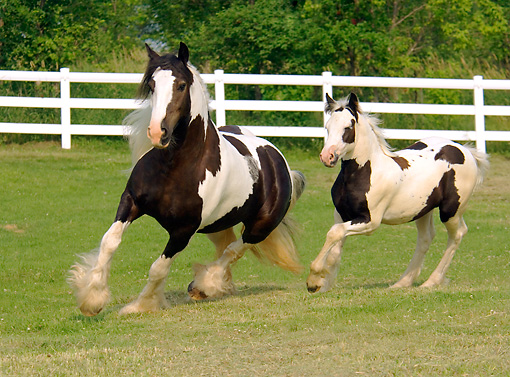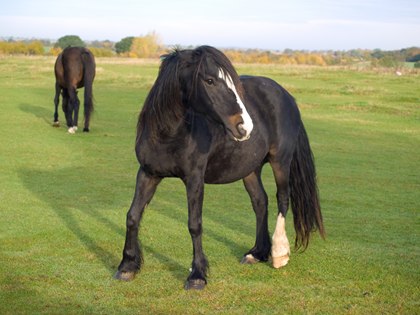So you have decided that you want a foal out of your favorite mare…..
She is your best show horse, never lame or sick, and can handle any type of rider on her back. You know she won’t be around forever, and she has the conformation, genes, and temperament that you want in all of your horses. Once you start thinking of her future foal(s), you start to get really excited. And getting her in foal should be pretty easy, right? Just throw the mare and stallion in a pasture together and they will get the job done. Then 11 months later you will have a beautiful healthy foal running around your pasture with its mother while you sit on your porch and enjoy a lovely cup of coffee.

Source: kimballstock.com
Sorry to interrupt the daydream, but here comes the voice of reason :(.
Things are usually not quite that simple. Yes, the above scenario sometimes does happen. However, depending on multiple factors (breed of horse, age of mare, etc.), getting a mare in foal can be a challenge. I’d like to discuss some of the considerations, choices, and costs that the mare owner should be aware of before deciding to breed their horse.
Considerations
– Age of the mare: If your mare has never foaled before, she is termed a “maiden mare”. Older (over 13 years) maiden mares are notoriously difficult to get in foal for the first time. If your mare has had foals in the past but is now older (over 20 years) she may also have some troubles getting pregnant.
– Breed of horse: Depending on the type of stallion you would like to breed her with, you may not be able to have your mare bred by the stud in a pasture (“pasture bred”). Sometimes the nearest quality stallion is located hundreds of miles away, in which case you would have to trailer your mare out to that farm and leave her there until they told you she was bred. Then you get to trailer her back and have your vet confirm the pregnancy. Don’t get me wrong – this procedure is quite common in the Thoroughbred world – but most other breeds ship semen to you for artificial insemination. Artificial insemination is unfortunately not as simple as just injecting the semen into the mare and walking away – more on that later.
Choices
– The “stud”: One of the most exciting parts about getting a mare bred is getting to pick out her stallion. There are websites and magazines galore with beautiful pictures of stallions and lists of their accomplishments. And when you are dreaming of that foal it is fun to picture what each stallion could contribute to compliment your mare’s traits. Some practical things to think about once you have narrowed down your search include:
1) The contract. CAREFULLY read and re-read the breeding contract and make sure you understand it. If not, ask your veterinarian or trainer or other horse professional to go over it with you. Some contracts have “live foal guarantees”, others do not. It is important to understand exactly what you are paying for and why.

Source: Equinelegalsolutions.com
2) The breeding stats. It is a good idea to know how many live foals this stallion has produced per year, how many mares he is bred to each year (his “booking”), and the average number of times a mare is bred to him before she gets pregnant. Additionally, if you are having his semen shipped for artificial insemination, you want to know how well the semen ships, and average number of shipments before a mare gets in foal. If a stallion owner says “This stallion got 10 mares in foal last year” – that is a very vague statement. You don’t know how many mares he attempted to breed, how many live foals were born, and what type of breeding took place. He could have bred over 100 mares, gotten 10 in foal, had 2 live foals, and bred 20 mares in pasture and 80 mares via artificial insemination. Ask the stallion owner the hard questions. If they refuse to answer them, then something fishy is going on and it is best to choose another stud.
3) The reputation of the stallion, breeding farm, and owner. This runs along the same line as the stats. If things seem kinda shady, they probably really are. A stallion owner who is trying to sell semen should want to work with potential buyers and answer their questions honestly and promptly. If you request to visit their farm, they should be more than happy to take you on a tour! You are the customer and the way they make money. Obviously, don’t be obnoxious and call at weird hours :). A good piece of advice is to speak with other mare owners and get recommendations on studs and breeding farms.
– Type of breeding. Almost every breed association accepts foals born from artificial insemination (The Jockey Club / Thoroughbreds are the only one I know of that insists on having natural mating take place). If you decide to have your mare bred via AI (artificial insemination), then you may need to choose between frozen semen or cooled, fresh semen. The costs and breeding statistics differ between the two, so careful consideration needs to be made when choosing. Which brings us to the costs….
Costs
Costs can add up very quickly when breeding a mare. For each type of breeding, lets talk about the costs that can surprise mare owners.
Natural/pasture breeding
1) Trailering to and from the stud – gas, wear and tear on trailer, travel fees (food, hotel, etc).
2) Mare care at the breeding farm – food, vet care (for injuries, sickness, pregnancy checks). Mares usually live at the breeding farm until they get pregnant, so if it takes 2 or 3 cycles for her to get pregnant you could be looking at those costs for 2-3 months.
4) Follow up vet care – have your vet make sure the mare is still pregnant.
Artificial Insemination – Frozen or Cooled Semen
1) Initial vet exams to determine timing of breeding – Artificial insemination needs to take place very close to ovulation (preferably 24 hours before ovulation) so the sperm will reach the egg soon after it is released. This requires that a vet does serial ultrasonic evaluations to determine the when the mare is going to ovulate. Each ultrasound costs money, as does the vet visit. Often a more money-saving method is to leave your mare at the vet clinic and have them do the ultrasounds and actual insemination when it is time.
2) Cost of shipping semen – Semen must be shipped overnight to the mare, which can be expensive. Additionally, each semen collection from the stallion may have its own separate fee. The breeding contract should spell all of this out.

Source: chincoteagueislandvacations.com
For any type of breeding there is always the chance that it takes more than one attempt to get pregnant. In nature or in wild herds, the average foaling rate is around 50-75%. That is with multiple natural breedings over a season in a low-stress environment. Now put the horse in a higher stress environment with semen that has been shipped across the country and the chance that the mare gets pregnant in one try decreases to around 50% or less. Horse owners often are shocked if their mare does not end up pregnant after one attempt at breeding and are dismayed when they only budgeted for one round of insemination. A good source for hard data regarding breeding statistics is on the Select Breeders website.
Additional expenses may be incurred depending on the individual mare. Some mares have immune reactions to the semen, which causes very unfavorable environment for a pregnancy to occur. Your vet may attempt to fix this reaction with antibiotics, anti-inflammatories, and uterine lavaging. Other times the mare may need a small surgical procedure to correct vaginal conformation abnormalities. Hormonal injections may be needed to ensure the mare ovulates within a specific timeframe. Your mare also may need to be supplemented with progesterone-like hormones to maintain her pregnancy. Each case is different, so it is best to plan for a flexible budget when it comes to breeding. Breeding horses can become complicated and expensive, which can lead to frustrated mare owners. Careful considerations regarding the stallion, type of breeding used, and budget planning can go a long way to easing the stress of getting a mare pregnant. I hope to add more posts regarding the details of artificial insemination and horses, but first I wanted to give a broad overview of the information owners need to be aware of before breeding their mare.






